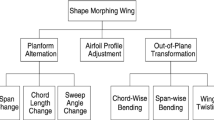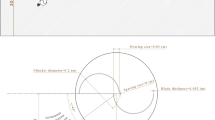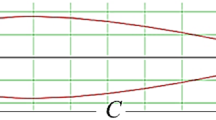Abstract
In this paper, aerodynamic optimization of the tangential stacking line of the NASA Rotor 37 as a transonic axial flow compressor rotor is carried out using computational fluid dynamics and genetic algorithm. To cover a wide range of curves with a minimum number of design parameters, a B-spline curve with three control points at 33, 66 and 100% of the blade span is used to define the blade stacking lines. Firstly, by rotating the tangential position of the control points, different rotors have been created and are simulated using the Navier–Stokes governing equations. Then, using genetic algorithm operators, based on the adiabatic efficiency as an objective function, new blades are created and numerically simulated. This process is repeated to achieve maximum adiabatic efficiency. The comparison of the optimum blade and the original blade indicates that optimal tangential stacking line causes the shock wave to move downstream and reduce the secondary flow which has led to an improvement of about 1.7% of the adiabatic efficiency.
















Similar content being viewed by others
Abbreviations
- C P :
-
Pressure coefficient
- Exp.:
-
Experimental
- LE:
-
Leading edge
- M tip :
-
Rotor tip relative Mach number
- PRPeak :
-
Pressure ratio at max efficiency
- P :
-
Static pressure
- P 0 :
-
Total pressure
- T 0 :
-
Total temperature
- y + :
-
Non-dimensional wall distance
- η :
-
Adiabatic efficiency
- θ 1 :
-
Lean angle at 33% span
- θ 2 :
-
Lean angle at 66% span
- θ 3 :
-
Lean angle at 100% span
- ACM:
-
Additive correction multi-grid
- CFD:
-
Computational fluid dynamics
- GA:
-
Genetic algorithm
- MCA:
-
Multi-circular arc
- SST:
-
Shear Stress Transport
References
Gallimore SJ, Bolger JJ, Cumpsty NA et al (2002) The use of sweep and dihedral in multistage axial flow compressor blading-part II: low and high-speed designs and test verification. J Turbomach 124:531–541
Gallimore SJ, Bolger JJ, Cumpsty NA et al (2002) The use of sweep and dihedral in multistage axial flow compressor blading-part I: university research and methods development. J Turbomach 124:521–532
Bergner J, Hennecke DK, Hoeger M et al (2003) Darmstadt rotor no.2- part II: design of lean rotor blades. Int J Rotat Mach 9:385–391
Ahn CS, Kim KY (2003) Aerodynamic design optimization of a compressor rotor with Navier–Stokes analysis. Proc Inst Mech Eng Part A J Power Energy 217:179–183
Denton,J D, Xu L (2002) The effects of lean and sweep on transonic fan performance. In: Proceeding of ASME TURBO EXPO 2002, Amsterdam, 3–6 June 2002, paper no. GT-2002-30327
Oyama A, Liou MS, Obayashi SH (2003) High-fidelity swept and leaned rotor blade design optimization using evolutionary algorithm. In: 16th AIAA computational fluid dynamics conference, Orlando, Florida, 23–26 June 2003, paper no. AIAA 2003-4091
Jang CM, Samad A, Kim KY (2006) Optimal design of swept, leaned and skewed blades in a transonic axial compressor. In: Proceedings of GT2006 ASME turbo expo 2006: power for Land Sea and air, Barcelona, 8–11 May 2006, paper no. GT-2006-90384
Yang L, Hua O, Zhao-Hui D (2007) Optimization design and experimental study of low-pressure axial fan with forward-skewed blades. Int J Rotat Mach Article ID 85275
Benini E (2004) Three-dimensional multi-objective design optimization of a transonic compressor rotor. AIAA J Propuls Power 20(3):559–565
Benini E, Biollo R (2007) Aerodynamics of swept and leaned transonic compressor-rotors. J Appl Energy 84:1012–1027
Razavi SR, Boroomand M (2014) Optimal design and aerodynamics Study of leaned transonic axial flow fan rotors. In: ASME 2014 international mechanical engineering congress and exposition, Montreal, 14–20 Nov 2014, Paper no. IMECE 2014-39796
Piegl L, Tilles W (1997) The NURBS book, 2nd edn. Springer, Berlin
Moore RD, Reid L (1980) Performance of single-stage axial flow transonic compressor with rotor and stator aspect ratios of 1.19 and 1.26, respectively, and with design pressure ratio of 2.05, NASA-TP-1659
Dunham J (1998) CFD validation for propulsion system components. AGARD-AR-355
ANSYS-CFX (2016) Release 17.0, ANSYS Inc.
Hutchinson BR, Raithby GD (1986) A multigrid method based on additive correction strategy. J Numer Heat Transf 9(5):511–537
Launder BE, Spalding DB (1974) The numerical computation of turbulent flows. J Comput Methods Appl Mech Eng 3:269–289
ANSYS CFX (2016) Release 17.0, Solver theory guide, ANSYS Inc.
Haupt RL, Haupt SE (2004) Practical genetic algorithms, 2nd edn. Willy, Hoboken
Author information
Authors and Affiliations
Corresponding author
Additional information
Technical Editor: André Cavalieri.
Rights and permissions
About this article
Cite this article
Asghari, M., Agha Seyed Mirzabozorg, M. & Adami, M. Aerodynamic optimization of the tangential stacking line of a transonic axial flow compressor rotor using genetic algorithm. J Braz. Soc. Mech. Sci. Eng. 41, 37 (2019). https://doi.org/10.1007/s40430-018-1500-2
Received:
Accepted:
Published:
DOI: https://doi.org/10.1007/s40430-018-1500-2




